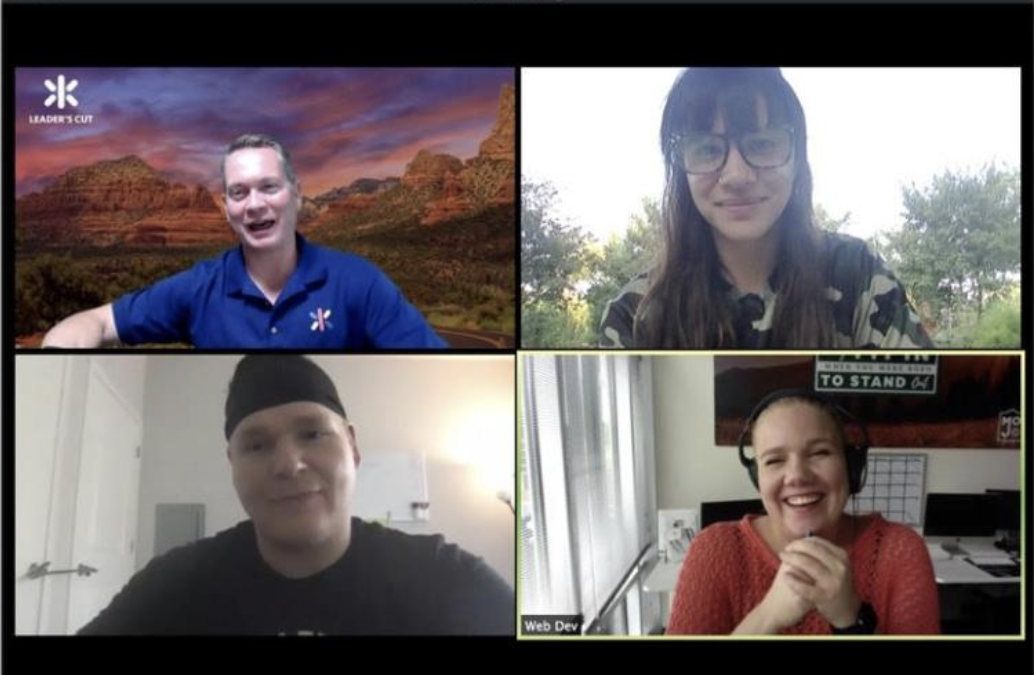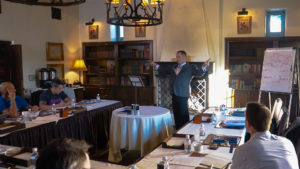In 2010, I was promoted to lead both a local team as well as one in another city. Later we and others would use corporate jargon to describe them as, ‘dispersed teams’. Added to the mix was that for the first time my boss was located in a different city than I or my teams. We quickly became aware of our own blindspots – most notably the notion that just because I (or my boss) wasn’t a witness to work didn’t mean it hadn’t happened. It also meant that a lifetime of habits and assumptions based on leading people we were physically near went out the window. As my career progressed, so did the number and size of teams spread across greater geography. Both the organization and I became more and more adept as being both effective and efficient using the convention of travel as well as getting better and better at emerging video technologies. Eventually these lessons were applied to creating, building, and growing client-offers that could be delivered digitally using video, screen sharing, on-line scheduling, etc.
As COVID-19 impacted nearly every worker in the world, I felt fortunate to have had the years, mentors, and training to be familiar with working, delivering, and performing in a digital world. Many companies that had been resisting incorporating technology and flexibility for both their workforce and clients were experiencing the bottom dropping out from under them as every one of their constituents demanded solutions.
Advantages of Digital Business Coaching
In full disclosure, I am an extroverted, social person that enjoys and is energized by being around other people. That said, I designed my coaching practice to operate in a digital environment, by applying the lessons learned from a long career in financial services, as both an adviser and leader. It’s the key reason Leader’s Cut has the infrastructure to schedule, deliver, and support all services via web/phone/chat/video.
While meeting in person offers clear, human contact and nuance we are all poignantly aware of, meeting digitally dramatically increases efficiency with little-to-no impact on effectiveness. Here’s what I mean. If I were to exclusively meet clients in person, the number of appointments is limited by the geography and commute time between each. It also limits the impact I can have to only the parts of Arizona within driving distance. Digital delivery eliminates commute time translating into more coaching time.
Further, most executive leaders and entrepreneurs that I work with nearly always present with concerns about time management. Specifically, they tell me they do not have enough time … ever. Add to this that we are all hard-wired to the social graces of meeting in person versus a phone/video call that a scheduled appointment of an hour easily becomes 75-90 minutes when we arrive a few moments early, offer beverages, and exchange small-talk both before and after.
The key advantage to coaching via phone/video is that we quickly get to the heart of the priorities, use our time wisely, and when done can move to a new priority with physically ushering people in and out of offices.
Disadvantages of Digital Business Coaching
While the COVID-era has challenged assumptions about forcing employees to tackle a long commute only to sit in an office or cube-farm wearing a phone headset all day, it has also helped anchor the gratitude we now have for human contact.
There is a trade-off between time efficiency and the social dynamic of having people in a room together. Where I’ve experienced the greatest challenge working digitally is with groups in particular. When interacting with an individual, holding attention is more natural. Yet when coaching a team on Zoom, especially a longer session, fatigue sets in rather quickly. It is more challenging to facilitate given that eye contact to acknowledge a person speaking or asking a question is a non-starter when on camera. And we cannot leave out the impulse to ‘multitask’ when we are part of a group, on video, but not being asked to speak.
Because using video technology is necessary with international teams, it must often be reserved for those types of situations to balance pushing teams toward video fatigue.
Conclusion
My favorite quote is from Jim Collins, “Never forego the beauty of the ‘AND’ at the tyranny of the ‘OR’”. In that spirit, we at Leader’s Cut approach our clients in the spirit of AND. We value meeting current and future clients in person and also incorporating video during executive coaching. We may conduct and EOSⓇ session in person, then conduct a smaller Team Effectiveness session via video. Thanks to technology, there is an abundance of flexibility in how we help our clients organize, create accountability, and communicate more effectively.
Ken Kilday is a Business Coach, EOS Implementer, and LinkedIn Expert using the principles of each to help clients refine their unique approach to their business to be even more effective. The best way to begin is to schedule a 15-minute meet-and-greet and chat.




